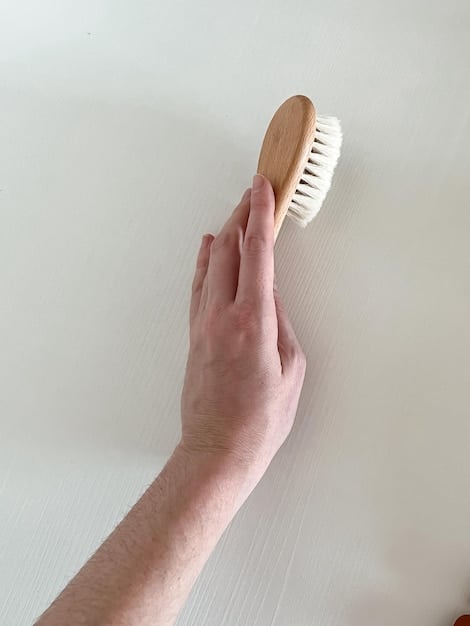DIY Deck Maintenance: Your Guide to Protect & Preserve

DIY Deck Maintenance: Protect Your Investment with These Annual Steps encompasses a series of tasks including cleaning, inspecting, repairing, and sealing to ensure longevity and safety, ultimately preserving your deck’s functionality and appearance.
A deck is an outdoor living space that adds value and enjoyment to your home. To keep it looking its best and ensure it lasts for years, regular maintenance is essential. This guide outlines key DIY Deck Maintenance: Protect Your Investment with These Annual Steps to keep your deck in top condition.
Essential Spring Cleaning for Your Deck
Spring cleaning isn’t just for the indoors; your deck needs it too. After weathering winter’s harsh conditions, decks often accumulate dirt, debris, and mildew. A thorough cleaning sets the stage for a season of outdoor enjoyment and helps identify any underlying issues needing attention.
Remove Debris and Sweep the Deck
Start by removing all furniture, planters, and other items from the deck. Use a broom or leaf blower to clear away leaves, twigs, and loose dirt. Pay special attention to gaps between boards where debris tends to collect.
Wash the Deck with a Cleaner
Choose a deck cleaner appropriate for your deck’s material. For wood decks, a specialized wood cleaner is ideal. Composite decks may require a different type of cleaner. Apply the cleaner according to the manufacturer’s instructions, usually involving scrubbing with a brush and rinsing with water.
- Choose the Right Cleaner: Select a cleaner that is specifically designed for your deck material. This will help prevent damage and ensure effective cleaning.
- Scrub Thoroughly: Use a stiff-bristled brush to scrub the deck surface, paying attention to areas with visible stains or mildew.
- Rinse Completely: Make sure to rinse the deck thoroughly with water to remove all traces of the cleaner. Residue can damage the deck over time or create a slippery surface.
- Allow to Dry: Before proceeding with any further maintenance steps, allow the deck to dry completely. This can take anywhere from a few hours to a full day, depending on the weather.

By thoroughly cleaning your deck in the spring, you’re not only enhancing its appearance but also preparing it for the rest of the maintenance tasks. This sets the foundation for a deck that remains beautiful and functional throughout the year.
Annual Deck Inspection: Spotting Potential Problems
A deck inspection is crucial to identify any issues early before they become major problems. This involves checking the structural elements, surface boards, railings, and steps for signs of damage or wear. Regular inspections can save you time and money in the long run.
Check for Rot and Decay
Inspect the wood for signs of rot or decay, especially in areas that are frequently exposed to moisture. Use a screwdriver or awl to probe the wood for soft spots. If the wood is soft and easily penetrated, it may be rotting and need to be replaced.
Examine the Railings and Steps
Ensure that all railings and steps are sturdy and secure. Check for loose connections, wobbly posts, or damaged boards. Repair or replace any components that are not in good condition.
- Inspect the Ledger Board: The ledger board, which connects the deck to the house, is a critical structural component. Check for signs of rot, corrosion, and secure attachment to the house.
- Examine Support Posts and Beams: Ensure that the support posts and beams are in good condition and properly aligned. Look for signs of cracks, splits, or sagging.
- Check Fasteners: Inspect all screws, nails, and bolts for signs of corrosion or loosening. Tighten or replace any fasteners as needed.
- Look for Water Damage: Check for areas where water may be pooling or draining improperly. Address any drainage issues to prevent future damage.
Conducting an annual deck inspection allows you to catch potential problems early and address them before they escalate. This proactive approach will extend the life of your deck and keep it safe for you and your family.
Repairing Damaged Deck Boards
Damaged deck boards not only detract from your deck’s appearance but can also pose a safety hazard. Whether it’s a cracked, splintered, or rotting board, timely repairs are essential to maintaining the integrity of your deck. Knowing how to replace and repair these boards is an important skill for any homeowner.
Replacing a Damaged Board
If a board is severely damaged, replacement is the best option. Start by removing the old board, using a pry bar if necessary. Install a new board of the same dimensions, securing it with deck screws.
Repairing Minor Damage
For minor damage like small cracks or splinters, wood filler can be used. Apply the filler to the damaged area, let it dry, and then sand it smooth. This will help to restore the appearance and prevent further damage.
- Use the Right Tools: Ensure you have the necessary tools, such as a drill, screwdriver, saw, pry bar, and safety glasses.
- Prepare the Area: Before applying any filler or adhesive, clean the damaged area thoroughly. Remove any loose debris or splinters.
- Match the Finish: When replacing a board or using filler, try to match the existing finish as closely as possible. This will help the repair blend in with the rest of the deck.
Repairing damaged deck boards is a crucial part of deck maintenance. By promptly addressing any issues, you can prevent further damage and keep your deck looking its best. This not only enhances the aesthetic appeal but also ensures the safety and longevity of your outdoor space.
The Importance of Staining and Sealing Your Deck
Staining and sealing your deck are crucial steps to protect it from the elements. These treatments help prevent water damage, UV damage, and insect infestation. Regular staining and sealing will significantly extend the life of your deck and keep it looking beautiful.
Choose the Right Product
Select a stain or sealant that is appropriate for your deck material and the level of protection you need. Oil-based stains penetrate the wood better and offer excellent protection, while water-based stains are easier to apply and clean up. Clear sealants provide protection without changing the color of the wood.
Apply the Stain or Sealant
Before applying the stain or sealant, make sure the deck is clean and dry. Use a brush, roller, or sprayer to apply the product evenly. Follow the manufacturer’s instructions for application and drying times.

- Prepare the Surface: Before applying stain or sealant, ensure the deck is thoroughly cleaned and dry. Remove any old stain or sealant that is peeling or flaking.
- Apply Evenly: Apply the stain or sealant in thin, even coats. Avoid applying too much at once, which can lead to drips and runs.
- Work in Good Weather: Choose a dry, sunny day to apply stain or sealant. Avoid applying in direct sunlight or during periods of high humidity.
- Follow Manufacturer’s Instructions: Always follow the manufacturer’s instructions for the specific product you are using. This will ensure the best results and prevent any potential problems.
Staining and sealing your deck are vital to preserving its condition. These protective measures guard against damage from moisture, sunlight, and pests, ensuring your deck remains a beautiful and functional part of your home for many years.
Maintaining Composite Decks: A Different Approach
Composite decks offer the advantage of being low maintenance, but that doesn’t mean they don’t require any care. While they are resistant to many of the issues that plague wood decks, such as rot and insect damage, composite decks still need regular cleaning to prevent mold and mildew buildup.
Cleaning Composite Decks
Clean your composite deck regularly with soap and water or a specialized composite deck cleaner. Use a soft-bristled brush to scrub the surface and rinse thoroughly with water.
Preventing Mold and Mildew
Mold and mildew can grow on composite decks, especially in damp or shaded areas. Use a cleaner specifically designed to remove mold and mildew. Regularly sweep the deck to prevent the buildup of organic matter that can promote mold growth.
- Avoid Harsh Chemicals: When cleaning a composite deck, avoid using harsh chemicals like bleach or solvents, which can damage the surface.
- Use a Soft-Bristled Brush: Avoid using a stiff-bristled brush, which can scratch the surface of the composite material.
- Rinse Thoroughly: Make sure to rinse the deck thoroughly after cleaning to remove any residue.
- Check for Drainage Issues: Ensure that water is draining properly from the deck surface. Address any drainage issues to prevent water from pooling and promoting mold growth.
Maintaining a composite deck involves a different approach than maintaining a wood deck. By focusing on regular cleaning and preventing mold and mildew, you can keep your composite deck looking its best for years to come.
Extending Your Deck’s Life: Best Practices
Extending your deck’s life involves a combination of regular maintenance, preventative measures, and smart usage habits. By adopting these best practices, you can ensure that your deck remains a valuable and enjoyable part of your home for many years.
Regular Maintenance Schedule
Establish a regular maintenance schedule that includes cleaning, inspecting, and repairing your deck. This will help you stay on top of any potential issues and address them before they become major problems.
Protecting Your Deck from the Elements
Take steps to protect your deck from the elements, such as using covers for your furniture and ensuring proper drainage. This will help prevent water damage and reduce wear and tear.
- Use Protective Mats: Place protective mats under planters and heavy furniture to prevent scratches and stains.
- Trim Overhanging Vegetation: Trim any overhanging vegetation that could trap moisture and promote mold growth.
- Avoid Salt Use: If you live in an area with snow and ice, avoid using salt on your deck, as it can damage the surface. Use sand or other non-corrosive de-icers instead.
- Consider a Deck Cover: If you live in an area with extreme weather conditions, consider investing in a deck cover to protect your deck during the off-season.
Extending the life of your deck requires a commitment to regular maintenance and preventative measures. By following these best practices, you can ensure that your deck remains a beautiful and functional part of your home for many years.
| Key Point | Brief Description |
|---|---|
| 🧹 Spring Cleaning | Removes debris and prepares your deck. |
| 🔍 Annual Inspection | Identifies potential issues early. |
| 🛠️ Board Repairs | Fixes damage to ensure safety. |
| 🛡️ Sealing | Protects against weather and pests. |
Frequently Asked Questions
▼
You should clean your deck at least once a year, typically in the spring. However, if your deck is in a heavily shaded area or is exposed to a lot of dirt and debris, you may need to clean it more frequently.
▼
The type of cleaner you should use depends on the material of your deck. For wood decks, use a specialized wood cleaner. For composite decks, use a cleaner specifically designed for composite materials.
▼
The frequency of sealing your deck depends on the type of sealant you use and the weather conditions in your area. Generally, you should seal your deck every one to three years to maintain optimal protection.
▼
Yes, you can use a pressure washer to clean your deck, but be cautious. Use a low-pressure setting and a wide nozzle to avoid damaging the wood or composite material. Always follow the manufacturer’s instructions.
▼
To prevent mold and mildew, keep your deck clean and dry. Regularly sweep away debris and trim overhanging vegetation. Use a cleaner specifically designed to remove mold and mildew, and ensure proper drainage.
Conclusion
By following these DIY Deck Maintenance: Protect Your Investment with These Annual Steps, you can keep your deck in excellent condition, ensuring its longevity, safety, and aesthetic appeal. Regular maintenance not only preserves your investment but also enhances the enjoyment of your outdoor living space.





